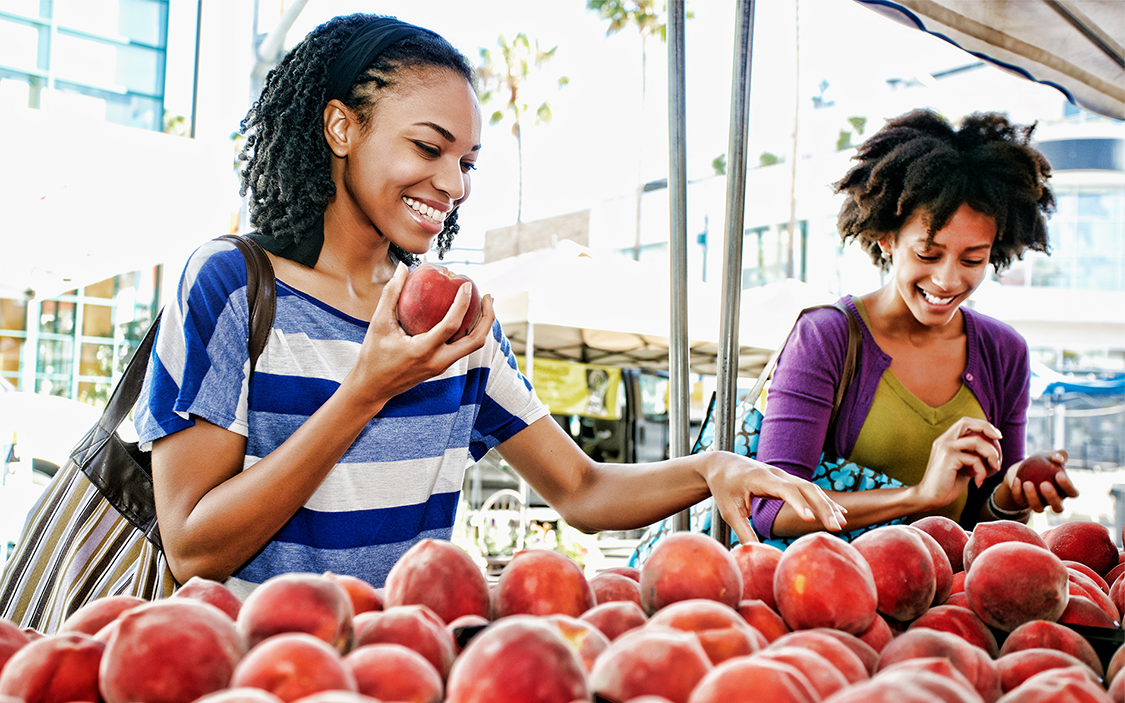
Boost performance and nutritional benefits by buying in-season produce. Here’s a refresher on why it’s important and how to make sure your investment lasts long enough for you to eat it!
What does in-season produce mean?
In-season produce includes items that are available due to the current climate. Some produce items prefer a colder, wetter climate to grow, while others prefer a warmer, dry climate. The list of in-season produce items varies not only by season but also geographic location.
Why buy in-season produce?
Purchasing in-season produce benefits the environment, local farmers and your wallet. In-season and locally grown produce does not have to be transported as far to get to your table because it usually comes from a nearby farm. This helps lower both travel emissions and prices for the consumer. When foods are in-season, they are generally richer in color, flavor and nutrients because they are picked closer to peak ripeness. This makes them a particularly great option for athletes aiming to get the most benefit from fruits and veggies.
How do you know if an item is in-season?
In general, price is a great starting point when looking for seasonal produce. When an item is in-season, there is generally a good amount of supply, making it generally more affordable. Strawberries are a good example. In winter, when strawberries are not in-season, they are often 2-3 times more expensive.
Another way to find in-season produce is to shop at your local farmers market or at a produce stand. In general, most farmers markets will primarily supply in-season produce because that’s what farmers can produce at the moment. Also, the Seasonal Food Guide lists seasonable produce by location and season.
Craving something that isn’t in-season? Frozen options are the next best choice! Frozen fruit and vegetables are picked when ripe and then flash-frozen to lock in nutrients and flavor. Buying frozen produce also cuts down on waste since it has a long shelf life and is less likely to spoil.
Summer In-Season Foods
- Apples
- Apricots
- Avocados
- Bananas
- Beets
- Bell Peppers
- Blackberries
- Blueberries
- Cantaloupe
- Carrots
- Celery
- Cherries
- Corn
- Cucumbers
- Eggplant
- Garlic
- Green Beans
- Honeydew Melon
- Lemons
- Lima Beans
- Limes
- Mangos
- Okra
- Peaches
- Plums
- Raspberries
- Strawberries
- Summer Squash
- Tomatillos
- Tomatoes
- Watermelon
- Zucchini
How to Store
Fruits and vegetables play a critical role in performance, and proper storage of fresh produce is the best way to ensure it lasts long enough for you to eat it. Use this guide as a reference the next time you start to unpack your groceries.
Cool, dark place
- Potatoes
- Onions
- Garlic
- Winter Squash
Refrigerator
- Apples (in a separate bin if possible)
- Artichokes
- Asparagus
- Beets
- Berries
- Bok Choy
- Broccoli
- Brussels Sprouts
- Cabbage
- Carrots
- Cauliflower
- Celery
- Chard
- Cherries
- Collard Greens
- Clementines
- Corn
- Cucumbers
- Eggplant
- Ginger
- Grapes
- Grapefruit
- Green Onions
- Herbs (not basil)
- Kale
- Lettuce
- Lemons and Limes
- Mushrooms
- Oranges
- Peas
- Peppers
- Spinach
- Summer Squash
- Watermelon
Keep on the counter
- Basil
- Bananas
- Persimmons
- Tomatoes
Ripen on counter, then refrigerate
- Apricots
- Avocados
- Cantaloupe
- Honeydew
- Kiwis
- Mangoes
- Nectarines
- Peaches
- Pears
- Plums
Peach BBQ Sauce Recipe
This peach BBQ sauce is a summer favorite with USA Volleyball’s national teams. It pairs great with chicken or pork and can also be used as a dressing for a spinach and strawberry salad.
Makes five servings
Ingredients
- Ancho Chili Powder: 1 tablespoon
- Crushed Red Pepper: 1 teaspoon
- Water: ¼ cup
- Peaches (pitted, fresh or frozen): ½ - 1 cup sliced or cubed
- Fresh Garlic: 2 cloves
- Honey or Agave: 2 tablespoons
- Apple Cider Vinegar: 1 tablespoon
- Olive Oil: 1 tablespoon
- Worcestershire Sauce: ½ tablespoon
- Smoked Paprika: ½ teaspoon
- Mustard Powder: ¼ teaspoon
- Salt: ½ teaspoon
- Pepper: ⅛ teaspoon
Blend all ingredients until smooth. Add more water to thin if necessary.
